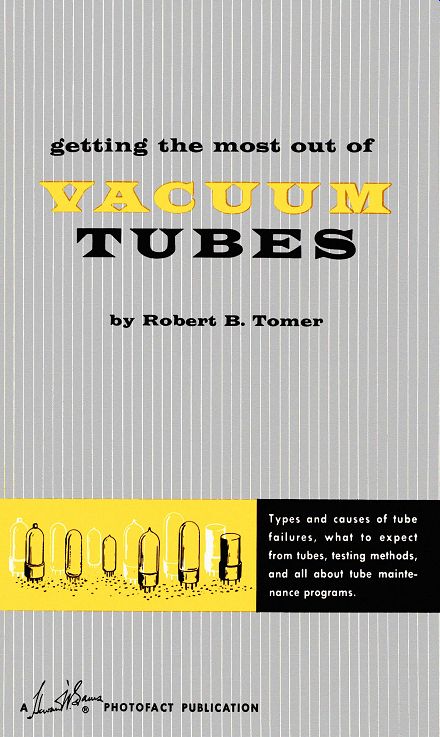Types and causes of tube failures, what to expect from tubes, testing methods, and all about tube maintenance programs.

CONTENTS
Section 1. CATASTROPHIC FAILURES -- Glass Failures-Heater Failures-Arcing-Fixed versus Bias
Section 2. DEGENERATIVE FAILURES -- Gas-Getters-Spurious Emissions-Interelectrode Leakage-Interface Resistance-Cathode Depletion
Section 3. SUBJECTIVE FAILURES -- Hum-Microphonics-Noise
Section 4. CHARACTERISTIC VARIABLES--Predicting Variables - How Standards Are Set - The Bogey Tube - The Limit Tube - Correlating Measurements-Typical Correlation-Characteristic Spreads Quality Control-Sampling-Design Tolerances
Section 5. SELECTED AND PREMIUM TUBES--How Tubes Are Selected-Results of Tube Selection Premium Tubes-The Multi-Spec Tubes-Standardization and Reliability-How Standards Are Set-Universal Tubes-The Universal Commodity-Defining Reliability-Reliability and Standardization
Section 6. WHY SO MANY TUBE TYPES?--Filament Voltage Sources-2-Volt and 6.3-Volt Tubes TV Types-Hybrid Types-Physical Changes-Miniatures and Subminiatures-Multipurpose Tubes-Electrical Characteristics-Competition-Technological Developments
Section 7. PREDICTING TUBE PERFORMANCE--Life Expectancy By Structure-Life Expectancy By Application - Tests for Initial Performance - Predicting Life
Section 8. TUBE TESTERS--Early Tube Testers-Classification of Tube Testers Shorts and Gas Tests-Maintenance Practices
Section 9. SPECIAL-PURPOSE TUBES--Filamentary Tubes-Low-Voltage Tubes-Phototubes Voltage-Regulator Tubes-Thyratrons
Section 10. METHODS FOR LENGTHENING TUBE LIFE--Measuring Bulb Temperature - Dissipation Control-Voltage and Current Regulation-Low-Voltage Operation-Mechanical-Maintenance
PREFACE
The purpose of this guide is not to add another volume to the many excellent ones available on what makes the vacuum tube work. Rather, it is intended to shed light on the almost completely neglected subject of why these versatile devices sometimes do not work.
Informed scientists and engineers have frequently stated that the life of a vacuum tube in normal service should exceed 5,000 or even 10,000 hours. The fact that some of them do not last this long is well known. The question then is, "Why do they so often give less than their predicted or possible potential?" J. M. Bridges, Director of Electronics, Office of the Assistant Secretary of Defense, speaking before the RETMA (now EIA) "Symposium on Reliable Applications of Vacuum Tubes" at the University of Pennsylvania in May 1956, said: "It has been demonstrated by service tests that the average number of tube failures per operating hour in two equipments of equal complexity, having approximately the same tube complement, can differ by as much as a factor of ten, due entirely to differences in the thoroughness and completeness of engineering design." If the failure rate of tubes in military equipment can vary as much as ten to one because of circuit design alone, what influence do maintenance practices have on over-all reliability and failure rates? For an answer to this, we refer to Aeronautical Radio's General Report, Number Two, on "Electronic Reliability in Military Applications;' July 1957, which states: "All available evidence indicates that this factor-the influence of maintenance personnel--is one of the dominant causes of unreliability in military equipments." Later in this same report we read, "The conclusion was reached that about one out of every three tubes removed from military equipment was a 'good tube.' " What can we deduce from all this? It appears possible that more effective maintenance practices can in some instances, reduce over-all tube failure rates by as much as 90%. Extensive military records, covering thousands of tubes in all types of electronic apparatus all over the world, have shown that these results are entirely possible.
It is for the purpose of pointing out those engineering practices leading to premature tube failures, and those maintenance practices contributing to additional failures, that this guide is written. I hope that, as a result of this knowledge, those responsible for the maintenance and servicing of home entertainment, business, industrial, and military equipment will gain a new appreciation of vacuum tubes, so they can obtain greater satisfaction from them in the future.
May, 1960
Also see:
Guide to Vacuum Tube Amplifier Circuits
Vacuum Tube high-fidelity in Mono: design, construction and measurements